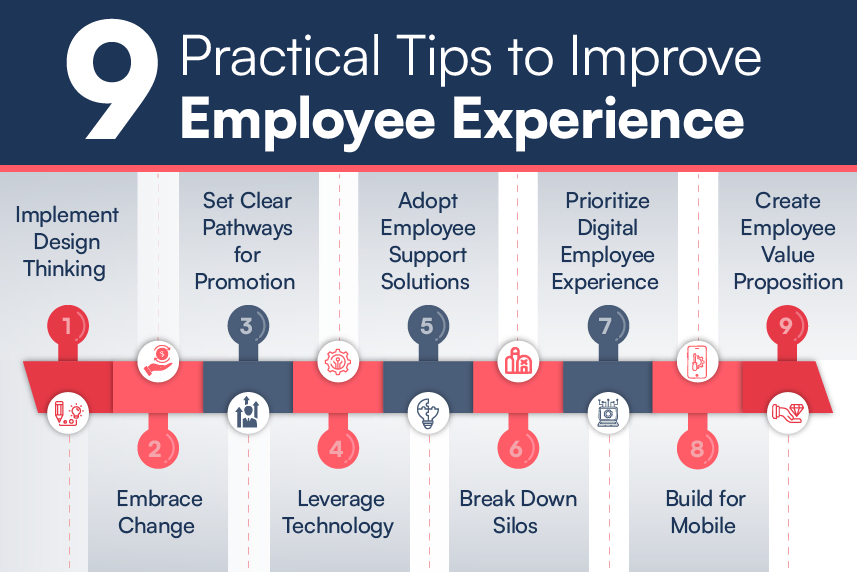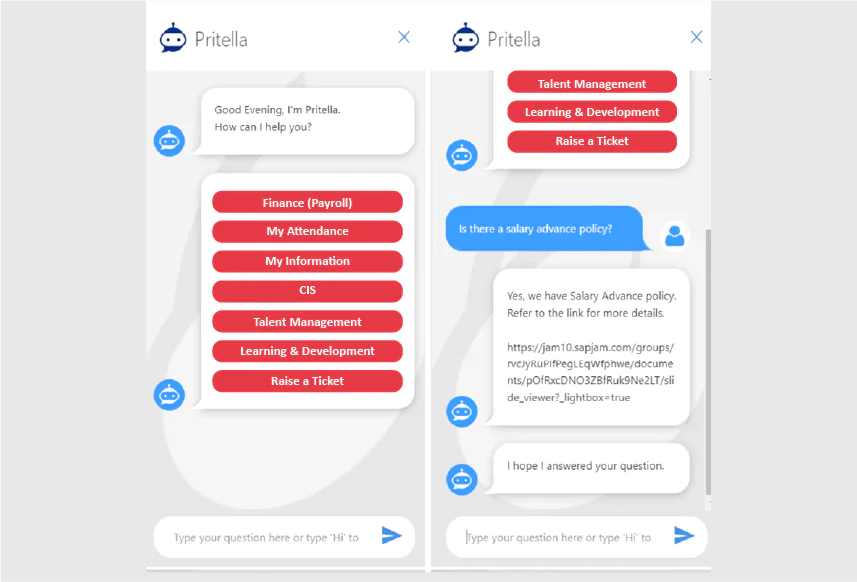
What You’ll Explore in this Employee Experience Guide
- Quick Facts
- Reimagining Employee Experience
- How Employers Can Transform Employee Experience
- 10 Employee Experience Tips for a Better Workplace
- Seeing the Big Picture of Employee Experience
- How to Improve EX at Each Stage of the Employee Lifecycle
- How Harbinger Resolved Employee Experience Challenges
- Harbinger’s HRTech Solutions Navigating the Future of Work
“In a world where money is no longer the primary motivating factor for employees, focusing on the employee experience is the most promising competitive advantage that organizations can create.”
– Jacob Morgan, Author, Speaker, And Futurist
Gone are the days when individuals only focused on monetary benefits while applying for a job. Times have changed, and so is their perception of seeking employment. They now look for opportunities that offer them the best employee experience.
To adapt and excel in this evolving market, L&D leaders, talent management professionals, and HR need to focus on employee experience more than ever. This will help overcome modern workplace challenges by recruiting, retaining, and inspiring the desired talent.
Quick Facts

Our Employee Experience Guide is here to help you withstand this disruption and create a lasting impact. It aims to reduce employee turnover, maximize retention, and improve customer experiences. So, without further ado, let’s dive right in.
Reimagining Employee Experience
Today’s digital age demands building value-driven workplaces, people-centric innovation, and technology inclusions that enable positive employee experiences.
Creating a modern employee experience is not about eliminating the traditional elements of team engagement, training, retention, and review. Instead, it means maximizing the impact of what already exists while encouraging agile initiatives.
How Employers Can Transform Employee Experience
There are various strategies that employers can implement to refine employee experience at workplaces. Let’s take a look at a few of them.

1. Human-Centric Work Design
With human-centric work models, employers can focus on empathy-based management and intentional collaboration, leading to impactful employee experiences. According to Gartner, employees operating in human-centric work settings are 3.2x more likely to stay with the company and experience 3.1x less fatigue.
2. Focused Employee Engagement
Deploying well-defined engagement practices is vital in establishing people-powered workplaces and improving job satisfaction, retention rate, and overall workforce productivity. It creates room for enhanced innovation and creativity within the organization. Moreover, it enables HR leaders to meet employee needs and concentrate on resolving their most pressing issues.
3. Dedicated Work-Life Balance
Providing a corporate setting where work-life balance is valued successfully caters to employee well-being. It can effectively foster positive employee experience journeys. It helps HR teams build trust and long-standing relationships with the overall workforce.
4. Flexible Work Hours
Encouraging flexible working helps employees align their work hours with their most productive times. This flexibility can help reduce stress, increase job satisfaction, and improve overall well-being, leading to a more optimistic employee experience.
5. Accountable Autonomy
Accountable autonomy offers employees the authority and responsibility to make business-critical decisions. Following this approach will help employers foster a sense of ownership, trust, and empowerment among employees.
6. Asynchronous Communication
Companies can devise an employee experience strategy encouraging managers to communicate through emails or asynchronous messaging platforms. This approach will reduce disruptions and enhance overall employee satisfaction by addressing the issue of unhealthy presenteeism.
10 Employee Experience Tips for a Better Workplace
Understanding the importance of employee experience and implementing the above strategies can take your business to the next level. Here are a few tips to help you make the most of your strategies.

1. Create Employee Value Proposition
Build a unique value (employee value proposition) that you can offer your employees in return for their skills, experience, and commitment to your company. Enable a workplace environment that emphasizes career growth and employee development. Value teamwork and collaboration to support employee mental health and well-being. Foster a culture of meritocracy, inclusivity, and professionalism.
2. Implement Design Thinking
Follow a problem-solving approach to deploy quality solutions that streamline employee engagement. Empathize with employees, analyze their queries, identify their pain points, prototype a solution, and repeat the process.
3. Measure Employee Engagement
Track qualitative and quantitative metrics like employee Net Promoter Score (eNPS), retention rate, autonomy, work-life balance, and recognition. Gather feedback through ad hoc surveys, multi-rater assessments, and census engagement surveys.
4. Set Clear Pathways for Promotions
Focus on skills and meritocracy. Ensure that employee promotions are based on a career pathing framework, which includes components like L&D accomplishments, milestones achieved, and goals completed.
5. Break Down Silos
Invest in the right employee experience tools and platforms to improve employee collaboration and communication. Eliminate isolated processes to help employees work toward common goals. Deploy collaboration software and assign cross-departmental liaisons.
6. Embrace Change
Revamp traditional processes by keeping up with the latest trends and ever-changing market demands. Be open to experimentation and iteration. Focus on the positive effects of change and convert every challenge into an opportunity.
7. Leverage Technology
Create a tech-based environment with chatbot integration, cloud-based solutions, conversational AI, and gamification. Automate necessary processes like shift scheduling, office access, and data collection. Invest in learning management systems to offer employees better learning and training opportunities.
8. Build for Mobile
Host employee-friendly facilities and solutions that ensure unmatched mobile experiences. Provide the required services via easy-to-navigate applications compatible with Android, iOS, and Windows mobile devices.
9. Prioritize Digital Employee Experience
Be it accessibility, inclusivity, or productivity, you must envelop every aspect of employee interaction with modern, digital employee experience tools. Curate a well-defined digital transformation strategy to support your employee experience management initiatives.
10. Adopt Proactive Employee Support Solutions
Create robust employee experience technology solutions to address and solve issues in real-time. Build internal help desks to support customer service teams. Channelize processes and best practices based on employee needs and convenience.
Seeing the Bigger Picture of Employee Experience
Now that you know the tips to create employee-friendly workplaces, let’s take a closer look at the fundamental building blocks of an exceptional employee experience.

Objective: Employees should know how their efforts contribute to the company’s success.
Expansion: Employees should get equal opportunities for skilling, career growth, and career diversification.
Transparency: Establishing a transparent feedback system is necessary to help employees achieve their goals.
Empowerment: Employees should have access to necessary data, tools, and resources that complement their efforts.
Connection: Initiatives taken by employees should be trusted, valued, and appreciated to ensure long-lasting relationships.
Well-Being: Safety, security, and DEI should be the top priorities for talent management.
How to Improve Employee Experience at Every Stage of Employee Lifecycle
To master employee experience, you must examine each stage of your employee lifecycle. From applying for a job to completing the exit formalities, identify what matters most to your employees and improve their experiences accordingly.

You must include necessary technology integrations in each stage of the employee lifecycle. This will help you optimize existing operations to improve the employee experience. How? Let’s find out.
1. Recruitment
Your company can automate job postings on various online platforms using AI and ML. You can use AI-based solutions for resume screening, candidate matching, and conducting virtual interviews. These solutions can also create a positive candidate experience through personalized communication, online assessments, and video introductions to the company culture.
2. Onboarding
You can provide new employees with access to digital onboarding tools and chatbots. These tools can focus on solving their queries and offering all relevant information about their role, company policies, and benefits. You can also facilitate electronic document signing, online training modules, and virtual workplace tours to drive positive experiences right from day one.
3. Development
Technology can support your L&D initiatives through eLearning platforms, virtual workshops, and webinars that offer continuous learning opportunities. You can deploy chatbots, voicebots, and language transformers to recommend personalized reskilling and upskilling courses. You can integrate performance assessment and feedback tools to help employees receive suggestions for career growth.
4. Promotion
HR teams can simplify the promotion process by automating performance evaluations. They can leverage performance management systems and other self-assessment, goal-tracking, and development planning tools. This can enable them to help employees demonstrate their capabilities and readiness for advancement opportunities. This can also provide data-driven insights to identify high-potential and talented employees.
5. Retention
You can retain talent by providing flexible work arrangements and on-demand training opportunities. You can automate repetitive and mundane administrative tasks to improve job satisfaction. This can be made possible with the use of technology integrations. You can integrate your existing HR and talent management systems with technologies like a learning management system, recognition and rewards platform, performance management software, self-service portal, and other collaboration tools.
6. Offboarding
You can successfully streamline the offboarding process by automating exit interviews, the management of knowledge transfer sessions, and the complete process of the return of company assets. You can provide access to digital platforms and resources for post-employment support, like career transition services. This can help maintain positive relationships with departing employees.
How Harbinger Resolved Employee Experience Challenges
Harbinger is instrumental in helping global clients improve their employee experience. Our HRTech experts formulate and deploy solutions that resolve complex employee experience challenges and exceed desired business goals.

Here’s a success story to help you understand how Harbinger simplified the employee experience journey for a global client.
Improved Employee Experience with AI-Enabled Chatbot
A Fortune 500 company with 800+ employees chose Harbinger to enhance its employee experience. We helped them deploy an AI-enabled office bot to ensure faster HR service delivery and employee engagement.
Problem Statement
Unable to remotely support employee queries 24×7.
Business Need
Incorporate a solution that ensures a continued positive employee experience.
Key Highlights
- Deploying an AI-enabled chatbot
- Integration with HR and other systems
Solution
- Customized and white-labeled AI-enabled office bot
- Cutting-edge AI/NLP technology
- Automated responses to employee queries
Result
- 24×7 remote HR support
- 90% of 5,000 employee queries were resolved through automation
- Reduced support-related costs by 30%
Let’s check out the snapshot of another success story to learn how we helped a technology company improve its employee engagement levels.
Enhanced Employee Engagement with Cloud-Based Chatbot
A US-based startup with a cloud-based platform was looking to boost employee engagement. They partnered with Harbinger to build a one-stop solution to meet this requirement. We helped them develop a feature-rich cloud-based chatbot to enhance employee engagement.
Problem Statement
Low employee engagement due to non-intuitive UI and lack of easy access to the continuous performance management platform.
Business Need
Develop a solution that improves employee engagement levels and continuous performance management platform usage.
Key Highlights
- UX process explicitly tailored for chatbots
- SSO for traversing continuous performance management and other workflows
- Easy integration with multiple channels and portals
Solution
- Development of feature-rich cloud-based chatbot
- AWS LEX with NLP to correctly identify and differentiate workflows
- Development of a custom connector to communicate with non-AWS channels
- Custom development of conversation history and notifications
Result
- Continuous performance management
- Seamless handling of multiple workflows
- 30% increase in employee engagement
Ready to Create Your Own Success Story?
You now have all the information to accelerate the employee experience journey. You just need to implement it properly. Not to worry, Harbinger is here to solve all your queries regarding improving the employee experience and meeting your HRTech needs on demand.

Our advanced HR chatbot “Pritella,” functions as an AI-assisted office buddy. This AI-powered office assistant can help HR teams ensure faster service delivery. What’s more interesting is that it operates on a quick response mechanism that takes employee engagement to the next level.
We have the HRTech competency and the right partners to provide automated and interactive employee and customer experience technology solutions. With our expertise in ChatGPT, Large Language Models, and other Generative AI technologies, ML algorithms, and NLP, we help businesses solve complex HR problems, including poor employee experience and low employee engagement.
Harbinger’s HRTech Solutions Navigating the Future of Work
Harbinger is a global technology company committed to providing top-tier future-ready HRTech solutions. Partnering with us will help you convert every challenge into an opportunity and shape the future of HR, work, and learning. Our transformative HRTech solutions have helped companies:
- Deliver a world-class employee experience
- Embrace digital transformation and employee-first thinking
- Shape the future of HR and accelerate HR vision
- Make data-driven people decisions
At Harbinger, we understand that building a great solution requires in-depth knowledge of the user, business nuances, and technology expertise.
Our HRTech experts aim to simplify the employee lifecycle with advanced solutions and people analytics. We help your organization build robust and scalable HR systems to attract people, keep them engaged, and develop and grow them in the workplace and in their professional careers. Here are some of our HRTech offerings:
- Automated Candidate Referencing
- Employee Verification
- Automated and Configurable Workflows
- Rewards and Recognition Apps
- Gamified Learning
Our HRTech experts help companies improve employee experience and overcome modern workplace challenges by focusing on essential factors like:
- Corporate reskilling and upskilling
- Hybrid work models
- Diversity, equity, and inclusion (DEI)
- Employee data privacy
- People-centered technology integrations
End Note
The key to improving the employee experience is building people-powered workplaces that consistently prioritize the workforce’s needs. It is about investing in modern technologies to create solutions that support, engage, motivate, and empower employees at every stage of their employment journey.
If you want to build an HRTech system or discuss your employee experience technology needs, write to us at contact@harbingergroup.com. Our HRTech experts would be more than happy to help you.





